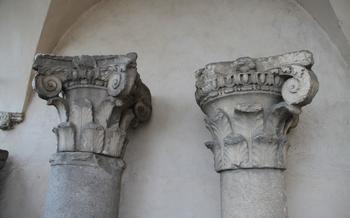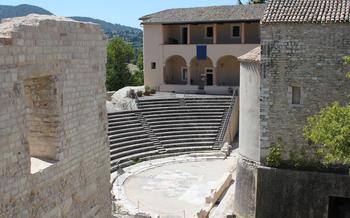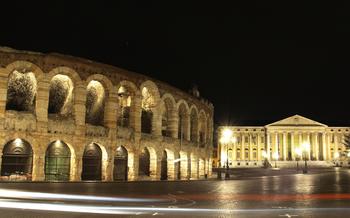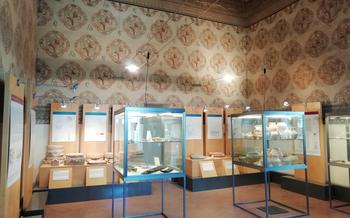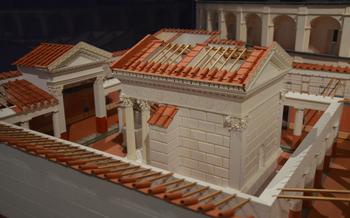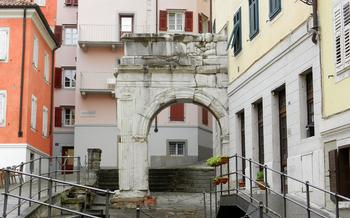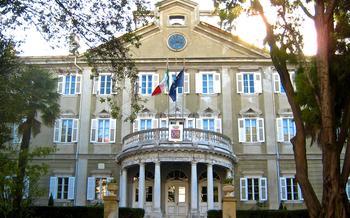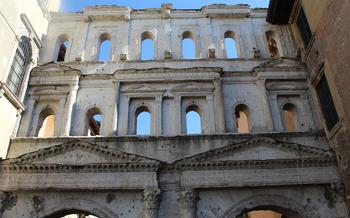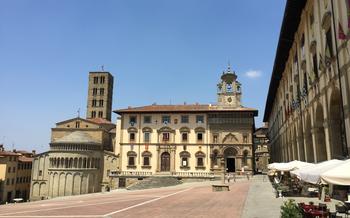
Museo Archeologico del Teatro Romano
- Historical Background
- Collection Highlights
- Archaeological Significance
- Interactive Displays
- Guided Tours
- Accessibility
- Educational Programs
- Gift Shop
- Nearby Attractions
- Opening Hours and Admission Fees
- Getting There
- Photography and Videography
- Anecdote
- Insider Tip
Historical Background
The Teatro Romano, Verona's ancient Roman theater, holds a captivating history that dates back to the 1st century AD. Constructed under the reign of Emperor Augustus, it served as a venue for theatrical performances, gladiatorial contests, and public assemblies. This magnificent structure reflects the grandeur of Roman architecture, featuring a well-preserved cavea (seating area) divided into different sections based on social status.
The Museo Archeologico del Teatro Romano, housed within the theater's premises, was established in the early 1900s. It emerged from the need to preserve and showcase the numerous artifacts discovered during archaeological excavations at the site. The museum's collection grew over the years, incorporating finds from not only the theater but also other Roman sites in Verona.
Today, the Museo Archeologico del Teatro Romano stands as a testament to the enduring legacy of Roman civilization in Verona. Its artifacts and exhibits offer a glimpse into the daily lives, customs, and artistic expressions of the ancient Romans who once inhabited this city.
Collection Highlights
Among the many notable artifacts and exhibits in the Museo Archeologico del Teatro Romano, some stand out for their significance in understanding Roman art, culture, and daily life. One such highlight is the statues of the four muses, which were once part of the decoration of the teatro. These statues represent the divine patrons of the arts and sciences and showcase the exceptional skill of Roman sculptors.
Another notable piece is the Bacchic relief, which depicts the Roman god of wine and revelry, Bacchus, surrounded by his followers. This relief offers a glimpse into the religious practices and mythological beliefs of the ancient Romans.
The museum also houses a collection of mosaics, which were used to decorate the floors of Roman homes and villas. These mosaics depict various scenes, including mythological figures, animals, and geometric patterns, providing valuable insights into Roman art and aesthetics.
Moreover, the museum displays inscriptions and epitaphs that were once part of Roman tombs and monuments. These inscriptions offer firsthand accounts of the lives and achievements of ordinary Romans, shedding light on their social structure, customs, and beliefs.
Each of these artifacts contributes to the museum's rich collection, allowing visitors to delve into the diverse and multifaceted aspects of Roman culture and history.
Archaeological Significance
The Museo Archeologico del Teatro Romano is not just a treasure trove of artifacts; it also holds immense significance for understanding Roman urban planning, architecture, and construction techniques. The ruins of the Teatro Romano, with its well-preserved seating tiers, stage, and orchestra pit, offer a glimpse into the architectural prowess of the Romans. The artifacts on display, such as building materials, decorative elements, and plumbing systems, provide insights into the construction methods and engineering marvels of the Roman era.
By studying the layout of the theatre, archaeologists have gained valuable knowledge about Roman urban planning principles. The theatre's strategic location, acoustics, and seating arrangements reveal how the Romans designed public spaces to accommodate large gatherings and optimize entertainment experiences.
Furthermore, the museum's collection of sculptures, mosaics, and inscriptions helps shed light on the artistic and cultural influences that shaped Roman society. These artifacts not only beautified the theatre and its surroundings but also conveyed messages, commemorated events, and celebrated Roman achievements.
In conclusion, the Museo Archeologico del Teatro Romano serves as a vital resource for understanding the archaeological significance of Roman urban planning, architecture, and construction techniques. Through its collection and exhibits, the museum preserves and promotes the rich cultural heritage of ancient Rome, offering visitors a deeper appreciation for the enduring legacy of Roman civilization.
Interactive Displays
The Museo Archeologico del Teatro Romano offers a range of interactive displays and multimedia exhibits to enhance the visitor experience and make learning about Roman history and culture more engaging and immersive. These interactive elements allow visitors to connect with the artifacts on a deeper level and gain a better understanding of the Roman world.
One of the highlights is the virtual reality experience that transports visitors back in time to the ancient Roman city of Verona. Using VR headsets, visitors can explore the streets, temples, and monuments of the city, gaining a firsthand perspective of what life was like during the Roman era.
The museum also features interactive touchscreens that provide in-depth information about the artifacts on display. Visitors can learn about the history, significance, and techniques used to create each artifact, as well as its role in Roman society.
Another interactive exhibit allows visitors to try their hand at deciphering ancient Roman inscriptions. Using a digital interface, visitors can attempt to translate Latin inscriptions and uncover the stories they hold.
These interactive displays not only make the museum more enjoyable and engaging for visitors of all ages but also contribute to a deeper understanding and appreciation of Roman history and culture.
Guided Tours
The Museo Archeologico del Teatro Romano offers guided tours in Italian, English, French, German, and Spanish, with tours tailored to specific interests, such as art, history, or architecture. These tours provide an immersive experience, allowing visitors to gain insights from expert guides who share their knowledge of Roman history and culture. The guides bring the artifacts and exhibits to life, explaining their significance and context. Visitors can choose from different tour options, including regular group tours, private tours for smaller groups or individuals, and educational tours designed for schools and student groups. To book a guided tour, visitors can contact the museum in advance or inquire at the ticket counter upon arrival.
Accessibility
The Museo Archeologico del Teatro Romano is committed to ensuring that all visitors have an enjoyable and accessible experience. The museum features a range of accessibility features to accommodate visitors with disabilities. Wheelchair ramps and elevators provide easy access to all levels of the museum, allowing visitors to explore the exhibits and galleries comfortably. Additionally, audio guides with clear and concise descriptions of the artifacts are available for visually impaired visitors, enhancing their understanding of the museum's collection. These accessibility features demonstrate the museum's dedication to inclusivity, ensuring that everyone has the opportunity to learn about and appreciate Roman history and culture.
Educational Programs
The Museo Archeologico del Teatro Romano recognizes the importance of education and outreach in promoting knowledge and appreciation of Roman history and culture, especially among younger audiences. To this end, the museum offers a range of educational programs and workshops that cater to different age groups and interests.
These programs are designed to engage students and families in active learning experiences that bring Roman history to life. They include interactive workshops, lectures by experts, and family-friendly activities that encourage participants to explore the museum's artifacts and exhibits in a fun and educational way.
One of the most popular programs is the "Roman Day" workshop, which allows students to experience a day in the life of a Roman citizen. Through hands-on activities and role-playing, they learn about Roman customs, clothing, food, and daily life.
The museum also offers guided tours specifically tailored for school groups, which provide an in-depth exploration of the Teatro Romano and its significance. These tours are led by experienced guides who can answer questions and adapt the content to suit the age and interests of the students.
By participating in these educational programs, visitors of all ages can gain a deeper understanding of Roman history and culture, fostering a lifelong appreciation for the legacy of this ancient civilization.
Gift Shop
The Museo Archeologico del Teatro Romano also houses a well-stocked gift shop, offering visitors a unique opportunity to purchase souvenirs and mementos of their visit. The shop is located conveniently within the museum and provides a wide range of items to suit every taste and budget.
Visitors can choose from an assortment of books and publications related to Roman history, culture, and archaeology. These books offer in-depth knowledge and insights into the ancient Roman world, making them ideal for history enthusiasts and scholars alike.
In addition to books, the gift shop also offers a variety of souvenirs, including replicas of artifacts, postcards, and magnets. These souvenirs are meticulously crafted to resemble the originals, allowing visitors to take home a piece of Roman history.
For those seeking unique and memorable gifts, the gift shop offers a selection of jewelry, pottery, and other handcrafted items inspired by Roman designs. These items are not only beautiful but also serve as a reminder of the creativity and artistry of the ancient Romans.
The proceeds from the gift shop directly support the Museo Archeologico del Teatro Romano, ensuring the preservation and promotion of Roman cultural heritage for future generations. By purchasing souvenirs from the gift shop, visitors not only take home a piece of history but also contribute to the museum's ongoing efforts to share the wonders of the ancient Roman world with the public.
Nearby Attractions
The Museo Archeologico del Teatro Romano is conveniently located in the heart of Verona, surrounded by other notable attractions that visitors can explore. Just a short walk from the museum is the iconic Arena di Verona, the largest preserved Roman amphitheater in the world. Visitors can marvel at its impressive architecture and enjoy performances and concerts held within its ancient walls.
Adjacent to the Arena is Piazza Bra, the main square of Verona, which offers a lively atmosphere with outdoor cafes, shops, and street performers. The square is dominated by the 19th-century Palazzo della Gran Guardia, which houses art exhibitions and cultural events.
Another must-see attraction near the museum is Castelvecchio, a 14th-century castle that houses the Museo Civico di Verona. This museum showcases a diverse collection of art and artifacts from Verona's history, including paintings, sculptures, and archaeological findings. The castle itself is a remarkable example of medieval architecture and offers stunning views of the city from its ramparts.
By combining a visit to the Museo Archeologico del Teatro Romano with these nearby attractions, visitors can immerse themselves in the rich history and culture of Verona, experiencing the essence of this ancient Roman city.
Opening Hours and Admission Fees
The Museo Archeologico del Teatro Romano has specific opening hours that visitors should be aware of. During the summer season (April to September), the museum is open from 8:30 AM to 7:30 PM. In the winter season (October to March), the museum's hours are from 8:30 AM to 5:30 PM. It is closed on Mondays.
Admission fees vary depending on the visitor's status. Adults pay a standard fee, while children under 18 and students with a valid ID receive a reduced rate. Additionally, there are concessions for seniors, visitors with disabilities, and groups. Visitors can purchase tickets at the museum's ticket office or online through the museum's website.
It's worth noting that the museum offers free admission on the first Sunday of each month, allowing visitors to enjoy the exhibits without any cost. However, it's important to keep in mind that the museum may be busier during these free admission periods.
Getting There
The Museo Archeologico del Teatro Romano is conveniently accessible by public transportation, offering visitors multiple options for a hassle-free journey. Take advantage of the well-connected bus or tram lines that stop within walking distance of the museum. Alternatively, if traveling by car, you'll find ample parking options nearby. Whether you choose to navigate the city streets or utilize public transportation, reaching the museum is a breeze. Consult a map or follow these comprehensive directions to ensure a smooth and enjoyable journey.
Photography and Videography
The Museo Archeologico del Teatro Romano welcomes photography and videography for personal use, allowing visitors to capture their memories of the museum. However, it is essential to respect the guidelines and restrictions in place to preserve the artifacts and ensure a peaceful environment for all visitors. Flash photography is prohibited in the museum to avoid damaging the delicate artwork and sculptures. Using a tripod or other photography equipment may also be restricted in certain areas to prevent obstructing walkways or interfering with other visitors.
When recording videos, visitors are expected to be mindful of the noise level and not disturb other visitors or the museum staff. It is important to remember that the museum is a place of learning and contemplation, so maintaining a respectful atmosphere is crucial. By following these guidelines, visitors can capture their memories while ensuring the preservation and appreciation of this remarkable historical site for future generations.
Anecdote
Among the many captivating artifacts in the Museo Archeologico del Teatro Romano, one piece that particularly struck me was a small, intricately carved statue of a Roman goddess. Its exquisite craftsmanship and serene expression transported me back in time, as if I were witnessing a glimpse into the lives of the ancient Romans who had once revered this deity. The statue's presence in the museum served as a tangible reminder of the rich cultural and religious heritage of this ancient civilization.
Insider Tip
Insider Tip: For a unique and immersive experience, visit the Museo Archeologico del Teatro Romano during one of its special evening events or guided tours. These events often offer exclusive access to the museum after hours, allowing visitors to explore the artifacts and exhibits in a more intimate setting. Additionally, guided tours led by expert archaeologists or historians can provide in-depth insights into the history and significance of the collection, making the visit even more enriching and memorable. Check the museum's website or inquire at the information desk for details on upcoming events and tour schedules.
